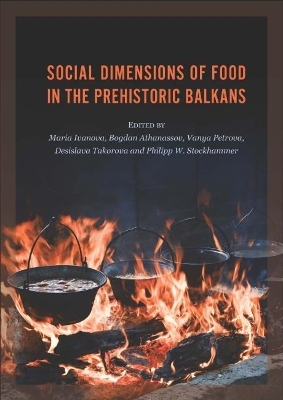
Social Dimensions of Food in the Prehistoric Balkans
Oxbow Books (Verlag)
978-1-78925-080-0 (ISBN)
Ever since the definition of the Neolithic Revolution by Vere Gordon Childe, archaeologists have been aware of the crucial importance of food for the understanding of prehistoric developments. Numerous studies have classified and described cooking ware, hearths and ovens, have studied food residues and more recently also stable isotopes in skeletal material. However, we have not yet succeeded in integrating traditional, functional perspectives on nutrition and semiotic approaches (e.g. dietary practices as an identity marker) with current research in the fields of Food Studies and Material Culture Studies. This volume brings together leading specialists in archaeobotany, economic zooarchaeology and palaeoanthropology to discuss practices of food production and consumption in their social dimensions from the Mesolithic to the Early Iron Age in the Balkans, a region with intermediary position between and the Aegean Sea on one side and Central Europe and the Eurasian steppe regions on the other side. The prehistoric inhabitants of the Balkans were repeatedly confronted with foreign knowledge and practices of food production and consumption which they integrated and thereby transformed into their life. In a series of transdisciplinary studies, the contributors shed new light on the various social dimensions of food in a synchronous as well as diachronic perspective. Contributors present a series of case studies focused on themes of social interaction, communal food preparation and consumption, the role of feasting, and the importance and management of salt production.
Maria Ivanova is lecturer in Prehistoric Archaeology at the University of Heidelberg. Her research area includes the Neolithic and Copper Age of East and Southeast Europe, with a particular focus on ancient technology, spheres of exchange, and the transmission of innovations. She is currently conducting research on the farming transition in the Balkans, the main corridor for the introduction of plant cultivation and animal herding from Anatolia into Europe. Bogdan Athanassov is an Assistant Professor for prehistoric archaeology and director of the Archaeometry and Experimental Archaeology Lab at the New Bulgarian University in Sofia. He studied archaeology in Bulgaria, Greece and Germany and his research focuses on archaeology of space, frontiers, and spatial and social marginality. Together with Philipp W. Stockhammer he co-directs the Bresto excavations in Southwest Bulgaria. Vanya Petrova lecturer in Textile Archaeology at St. Kliment Ohridski University of Sofia. She completed her PhD at the University of Sofia in 2011. Her main research interests are focused on the Bronze Age in Southeastern Europe, pottery and textile technology, environmental dynamics and subsistence strategies as factors in cultural transformation. Philipp W. Stockhammer is professor for prehistoric archaeology with a focus on the Eastern Mediterranean at Ludwig-Maximilians-University (LMU) Munich and co-director of Max Planck-Harvard Research Center for the Archaeoscience of the Ancient Mediterranean, Jena. His research focuses on the transformative power of intercultural encounters, human-thing-entanglements, social practices and the integration of archaeological and scientific interpretation.
Introduction: Social dimensions of food
Philipp W. Stockhammer, Bogdan Athanassov and Maria Ivanova
1 ‘Herd’ mentality
László Bartosiewicz and Clive Bonsall
2 Neolithic taboos in Anatolia and southeast Europe
Nerissa Russell
3 Eating out: Food and social context in the Early Neolithic of Greece
Kostas Kotsakis
4 Breath of change: Food and pottery in the course of the Neolithic in northern Greece
Dushka Urem-Kotsou
5 Carcasses, ceramics, and cooking at Makriyalos I: Towards an integrated approach to human diet and commensality in Late Neolithic northern Greece
Valasia Isaakidou and Paul Halstead
6 Painted pottery and culinary practices: Use-alteration analysis of painted pottery from the site of Starčevo-Grad
Olga Bajčev
7 Feasting during the Early Neolithic of the central Balkans: The fauna from Blagotin, Serbia
Haskel J. Greenfi eld and Tina L. Jongsma-Greenfield
8 Of pits and bones: A ritual pit at the late Neolithic site of Sarnevo in Bulgarian Thrace
Krum Bacvarov and John Gorczyk
9 Foraging and food production strategies during the Early Neolithic in the Balkans-Carpathian area. The site of Bucova Pusta in Romanian Banat
Raiko Krauss, Bea De Cupere and Elena Marinova
10 ‘No quern, no food’? Milling technology and the spread of farming in southeast Europe
Maria Ivanova
11 Prehistoric agricultural toolkits in diachronic perspective: A case study from Bulgaria
Maria Gurova
12 Social dimensions of salt in the later prehistory of the eastern Balkans
Vassil Nikolov
13 Salt in European prehistory: Social and economic considerations
Anthony Harding
14 Plant-based food at Chalcolithic and Early Bronze Age Drama, southeast Bulgaria: Continuity and innovations
Ralf Gleser and Elena Marinova
15 Food, status, and power: Animal production and consumption practices during the Carpathian Basin Bronze Age
Amy Nicodemus
16 Plant food from the Late Bronze and Early Iron Age hilltop site Kush Kaya, Eastern Rhodope Mountains, Bulgaria: Insights on the cooking practices
Hristo Popov, Elena Marinova, Ivanka Hristova and Stanislav Iliev
17 Food supply and disposal of food remains at Late Bronze and Early Iron Age Ada Tepe: Bioarchaeological aspects of food production, processing and consumption
Krassimir Nikov, Elena Marinova, Bea De Cupere, Ivanka Hristova, Yana Dimitrova, Stanislav Iliev and Hristo Popov
18 Hunting together: Social aspects of hunting at a 13th–12th century BC fortified site in southwestern Bulgaria
John Gorczyk, Bogdan Athanassov and Philipp W. Stockhammer
19 Where Angel feared not to tread: Anthropometric approaches to food studies in Aegean and Balkan prehistory
Eva Rosenstock and Alisa Scheibner
| Erscheinungsdatum | 09.10.2018 |
|---|---|
| Zusatzinfo | b/w and colour |
| Verlagsort | Oxford |
| Sprache | englisch |
| Maße | 170 x 240 mm |
| Themenwelt | Sachbuch/Ratgeber ► Essen / Trinken ► Gesunde Küche / Schlanke Küche |
| Geisteswissenschaften ► Archäologie | |
| Geschichte ► Allgemeine Geschichte ► Vor- und Frühgeschichte | |
| Sozialwissenschaften | |
| ISBN-10 | 1-78925-080-3 / 1789250803 |
| ISBN-13 | 978-1-78925-080-0 / 9781789250800 |
| Zustand | Neuware |
| Haben Sie eine Frage zum Produkt? |
aus dem Bereich


